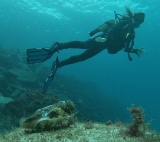Scuba diving has always aroused curiosity, as discovering what lies beneath the sea is something that captivates everyone at some point in life. The seabed continues to harbour all kinds of marine mysteries, and a practice with so many years of experience tells a fascinating story.
Early Uses of Diving Bells
After the discovery of America, the number of ships that set out to cross the Atlantic to reach the new continent increased. Around 1520, Ferdinand Magellan became the first person to attempt a depth sounding in the open sea after crossing the strait.
Upon reaching the Pacific Ocean (a name he coined himself), he tied together all the ropes on his vessel and dropped a lead weight into the water, thus confirming that the largest of oceans had a depth of over 180 metres. 
Many ships were wrecked, due to weather and battles, in the coastal waters of the numerous islands of what is now the Caribbean. Some vessels were sent from Europe to the wreck sites with the intention of recovering parts of the cargo. Using various diving bells, divers attempted to retrieve cannons, precious metals, and any other valuable remains from the shipments.
Meanwhile in Europe, with the arrival of the Renaissance, renewed interest in the exploration of the seabed spread among the scientific community. A prime example is Leonardo da Vinci (1452-1519), who designed boat-shaped shoes for walking on water and a type of webbed glove and flippers inspired by frog legs, which, along with a leather hood featuring a breathing tube, formed the first lightweight diving gear in history. Due to the prevailing fear of "sea beasts" at the time, he added numerous spikes to the hood to protect divers from marine animal attacks.
Years later, Leonardo himself would declare: "There is too much malice in men's hearts to entrust them with the secret of underwater exploration; they would not hesitate to bring murder to the depths of the sea."
Diving Bells in the 17th and 18th Centuries
The key evolution in diving bells occurred between the 17th and 18th centuries. Advancements included the addition of stabilising weights, the introduction of benches and stools for sitting inside, and the creation of small windows or glass viewports through which the seabed and the location of important wreckage could be observed for easier recovery.
But the most important breakthrough, sought for centuries, was finding a way to introduce air into the bell, renew it, and enable longer stays underwater.
The renowned astronomer Edmond Halley succeeded in 1690 (building on ideas by French physicist Denis Papin) by introducing external air into a diving bell. He first modified its design, increasing its dimensions (2.50 m tall and 2 m in diameter at the base), lining it with lead to withstand increased pressure and improve stability. He added a circular bench around the perimeter for resting inside.
How Was the Air Renewed?
The air was renewed by lowering barrels filled with air alongside the bell, which were emptied inside via tubes. The tube connected to the barrel was opened at the other end inside the bell. A hole was then made in the barrel, and as it flooded with water, the air passed into the bell.
Additionally, he gave divers some autonomy by providing them with a small personal bell connected via a tube to the main one. During testing, he dived with four other men, staying at a depth of 16 metres for about an hour.
A few years later, British carpenter John Lethbridge built a wooden cylinder, secured by two hoops to chains. The diver was positioned horizontally and had two holes to extend their arms below. Breathing the volume of air inside, they remained for over twenty minutes at 16 metres.
In 1734, in the French port of Marseille, it was used to recover a cargo of coins from a ship sunk at 10 metres. In 1735, his team retrieved 350 ingots and thousands of pieces from the wreck of the Dutch East Indiaman Slot Her Hooge off Portugal's coast.
Ultimately, all scientists of the era agreed that the goal was to continuously supply air to the bell to extend divers' autonomy. The first to achieve this was English engineer John Smeaton (1724-1792), who connected tubes to the bell linked to a pneumatic pump, allowing men on the surface to pump pressurised air inside.
The Use of Diving Bells in Spain
The first use of a diving bell in Spain (1538) did not occur at sea but in the Tagus River near Toledo. Englishman John Teniers recounted how two Greek divers demonstrated inside a bell, staying underwater for twenty minutes with lit candles before Emperor Charles V and his court.
This experience likely spurred interest in applying this technology to recover cargo from sunken Spanish ships. In 1626, Spaniard Núñez Melián, using a bell, recovered much of the gold and silver cargo from galleons sunk in the Caribbean.
Later, in 1654, off the coast of Cadaqués (Spain), Andreu Ximénez used a bell of his own design to explore this Mediterranean site's seabed.
Thus, from 1787 onwards, Spain established diver schools in Cartagena (Murcia), Cádiz, and El Ferrol (A Coruña), where trainees learned freediving using bells to breathe underwater.
















